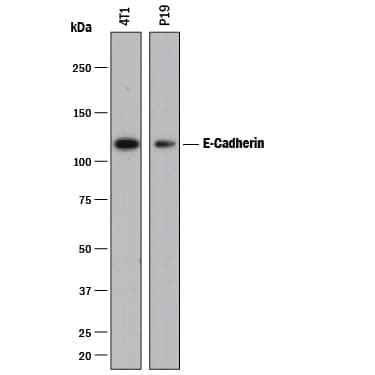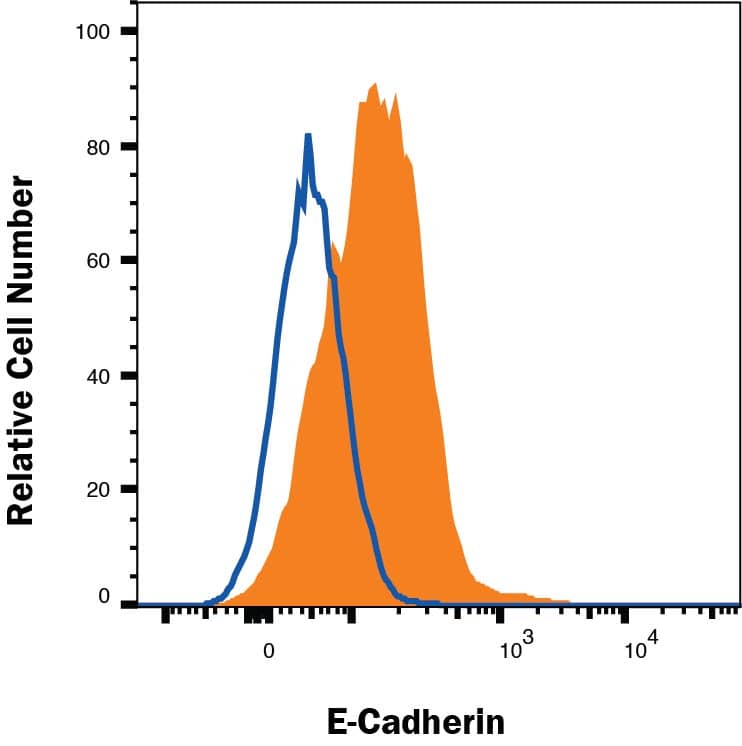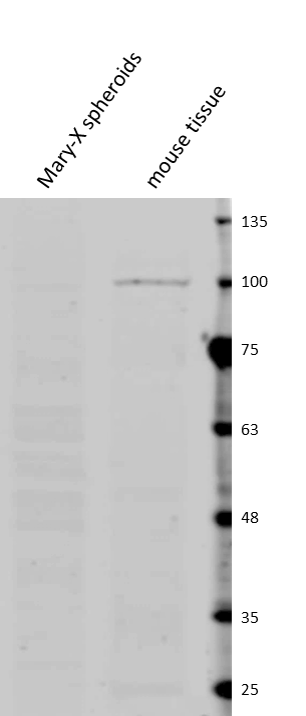Mouse E-Cadherin Antibody Summary
Asp157-Val709 (predicted)
Accession # P09803
Applications
Please Note: Optimal dilutions should be determined by each laboratory for each application. General Protocols are available in the Technical Information section on our website.
Scientific Data
 View Larger
View Larger
Detection of Mouse E‑Cadherin by Western Blot. Western blot shows lysates of P19 mouse embryonal carcinoma cell line and 4T1 mouse breast cancer cell line. PVDF membrane was probed with 2 µg/mL of Rat Anti-Mouse E-Cadherin Monoclonal Antibody (Catalog # MAB7481) followed by HRP-conjugated Anti-Rat IgG Secondary Antibody (HAF005). A specific band was detected for E-Cadherin at approximately 120 kDa (as indicated). This experiment was conducted under reducing conditions and using Immunoblot Buffer Group 1.
 View Larger
View Larger
Detection of E‑Cadherin in mlMCD3 cells by Flow Cytometry. mlMCD3 cells were stained with Rat Anti-Mouse E‑Cadherin Monoclonal Antibody (Catalog # MAB7481, filled histogram) or isotype control antibody (Catalog # MAB006, open histogram), followed by Phycoerythrin-conjugated Anti-Rat IgG Secondary Antibody (Catalog # F0105B). View our protocol for Staining Membrane-associated Proteins.
Reconstitution Calculator
Preparation and Storage
- 12 months from date of receipt, -20 to -70 °C as supplied.
- 1 month, 2 to 8 °C under sterile conditions after reconstitution.
- 6 months, -20 to -70 °C under sterile conditions after reconstitution.
Background: E-Cadherin
Epithelial (E) - Cadherin (ECAD), also known as cell-CAM120/80 in the human, uvomorulin in the mouse, Arc-1 in the dog, and L-CAM in the chicken, is a member of the cadherin family of cell adhesion molecules. Cadherins are calcium-dependent transmembrane proteins, which bind to one another in a homophilic manner. On their cytoplasmic side, they associate with the three catenins, alpha, beta, and gamma (plakoglobin). This association links the cadherin protein to the cytoskeleton. Without association with the catenins, the cadherins are non-adhesive. Cadherins play a role in development, specifically in tissue formation. They may also help to maintain tissue architecture in the adult. E-Cadherin may also play a role in tumor development, as loss of E-Cadherin has been associated with tumor invasiveness. E-Cadherin is a classical cadherin molecule. Classical cadherins consist of a large extracellular domain which contains DXD and DXNDN repeats responsible for mediating calcium‑dependent adhesion, a single-pass transmembrane domain, and a short carboxy-terminal cytoplasmic domain responsible for interacting with the catenins. A soluble form of E-Cadherin can be released from epithelial cell surfaces by proteolysis. E‑Cadherin contains five extracellular calcium‑binding domains of approximately 110 amino acids each.
- Bussemakers, M.J.G. et al. (1993) Mol. Biol. Reports 17:123.
- Overduin, M. et al. (1995) Science 267:386.
- Takeichi, M. (1991) 251:1451.
Product Datasheets
Citations for Mouse E-Cadherin Antibody
R&D Systems personnel manually curate a database that contains references using R&D Systems products. The data collected includes not only links to publications in PubMed, but also provides information about sample types, species, and experimental conditions.
15
Citations: Showing 1 - 10
Filter your results:
Filter by:
-
A dietary change to a high-fat diet initiates a rapid adaptation of the intestine
Authors: JR Enriquez, HA McCauley, KX Zhang, JG Sanchez, GT Kalin, RA Lang, JM Wells
Cell Reports, 2022-11-15;41(7):111641.
Species: Mouse, Transgenic Mouse
Sample Types: Whole Tissue
Applications: IHC -
IL-33 promotes gastric tumour growth in concert with activation and recruitment of inflammatory myeloid cells
Authors: CP Tran, M Scurr, L O'Connor, JN Buzzelli, GZ Ng, SCN Chin, LA Stamp, T Minamoto, AS Giraud, LM Judd, P Sutton, TR Menheniott
Oncotarget, 2022-06-01;13(0):785-799.
Species: Mouse
Sample Types: Whole Cells
Applications: Flow Cytometry -
Impaired neurogenesis alters brain biomechanics in a neuroprogenitor-based genetic subtype of congenital hydrocephalus
Authors: PQ Duy, SC Weise, C Marini, XJ Li, D Liang, PJ Dahl, S Ma, A Spajic, W Dong, J Juusola, E Kiziltug, AJ Kundishora, S Koundal, MZ Pedram, LA Torres-Fer, K Händler, E De Domenic, M Becker, T Ulas, SA Juranek, E Cuevas, LT Hao, B Jux, AMM Sousa, F Liu, SK Kim, M Li, Y Yang, Y Takeo, A Duque, C Nelson-Wil, Y Ha, K Selvaganes, SM Robert, AK Singh, G Allington, CG Furey, AT Timberlake, BC Reeves, H Smith, A Dunbar, T DeSpenza, J Goto, A Marlier, A Moreno-De-, X Yu, WE Butler, BS Carter, EMR Lake, RT Constable, P Rakic, H Lin, E Deniz, H Benveniste, NS Malvankar, JI Estrada-Ve, CA Walsh, SL Alper, JL Schultze, K Paeschke, A Doetzlhofe, FG Wulczyn, SC Jin, RP Lifton, N Sestan, W Kolanus, KT Kahle
Nature Neuroscience, 2022-04-04;25(4):458-473.
Species: Mouse
Sample Types: Whole Tissue
Applications: IHC -
Intraepithelial lymphocytes suppress the intestinal tumor growth by cell-to-cell contact via CD103/E-cadherin signal
Authors: R Morikawa, Y Nemoto, Y Yonemoto, S Tanaka, Y Takei, S Oshima, T Nagaishi, K Tsuchiya, K Nozaki, T Mizutani, T Nakamura, M Watanabe, R Okamoto
Cellular and Molecular Gastroenterology and Hepatology, 2021-01-28;0(0):.
Species: Mouse
Sample Types: Whole Tissue
Applications: IHC -
Beta 1-integrin ligation and TLR ligation enhance GM-CSF-induced ALDH1A2 expression in dendritic cells, but differentially regulate their anti-inflammatory properties
Sci Rep, 2016-11-29;6(0):37914.
Species: Mouse
Sample Types: Whole Cells
Applications: Neutralization -
The Semaphorin 4D-RhoA-Akt Signal Cascade Regulates Enamel Matrix Secretion in Coordination with Cell Polarization During Ameloblast Differentiation
J Bone Miner Res, 2016-10-26;0(0):.
Species: Mouse
Sample Types: Whole Cells, Whole Tissue
Applications: ICC, IHC-P -
The M33 G protein-coupled receptor encoded by murine cytomegalovirus is dispensable for hematogenous dissemination but is required for growth within the salivary gland.
Authors: Bittencourt F, Wu S, Bridges J, Miller W
J Virol, 2014-08-06;88(20):11811-24.
Species: Mouse
Sample Types: Whole Tissue
Applications: IHC-Fr -
Role of Rip2 in development of tumor-infiltrating MDSCs and bladder cancer metastasis.
Authors: Zhang, Hanwei, Chin, Arnold I
PLoS ONE, 2014-04-14;9(4):e94793.
Species: Mouse
Sample Types: Whole Tissue
Applications: IHC-P -
Integrin alpha9beta1 in airway smooth muscle suppresses exaggerated airway narrowing.
J. Clin. Invest., 2012-07-09;122(8):2916-27.
Species: Mouse
Sample Types: Whole Tissue
Applications: IHC-Fr -
E-cadherin-expressing feeder cells promote neural lineage restriction of human embryonic stem cells.
Authors: Moore RN, Cherry JF, Mathur V
Stem Cells Dev., 2011-06-01;21(1):30-41.
Species: Mouse
Sample Types: Whole Cells
Applications: ICC, Neutralization -
Timing is everything: Reiterative Wnt, BMP and RA signaling regulate developmental competence during endoderm organogenesis
Authors: Scott A. Rankin, Kyle W. McCracken, David M. Luedeke, Lu Han, James M. Wells, John M. Shannon et al.
Developmental Biology
-
miR-146b Functions as an Oncogene in Oral Squamous Cell Carcinoma by Targeting HBP1
Authors: Kui Li, Zheng Zhou, Ju Li, Rui Xiang
Technol Cancer Res Treat
-
Functional human gastrointestinal organoids can be engineered from three primary germ layers derived separately from pluripotent stem cells
Authors: AK Eicher, DO Kechele, N Sundaram, HM Berns, HM Poling, LE Haines, JG Sanchez, K Kishimoto, M Krishnamur, L Han, AM Zorn, MA Helmrath, JM Wells
Cell Stem Cell, 2021-12-01;0(0):.
-
FOXF1 transcription factor promotes lung morphogenesis by inducing cellular proliferation in fetal lung mesenchyme
Authors: Vladimir Ustiyan, Craig Bolte, Yufang Zhang, Lu Han, Yan Xu, Katherine E. Yutzey et al.
Developmental Biology
-
E‑cadherin regulates biological behaviors of neural stem cells and promotes motor function recovery following spinal cord injury
Authors: Dong Chen, Siyuan Hu, Jie Liu, Shaohua Li
Experimental and Therapeutic Medicine
FAQs
No product specific FAQs exist for this product, however you may
View all Antibody FAQsReviews for Mouse E-Cadherin Antibody
Average Rating: 4.5 (Based on 2 Reviews)
Have you used Mouse E-Cadherin Antibody?
Submit a review and receive an Amazon gift card.
$25/€18/£15/$25CAN/¥75 Yuan/¥2500 Yen for a review with an image
$10/€7/£6/$10 CAD/¥70 Yuan/¥1110 Yen for a review without an image
Filter by:
Comparative expression of mouse E-cadherin in human breast cancer Mary-X spheroids extracted from tumor and the surrounding nu/nu mouse tissue. Dilution: 1:500 in 5% BSA in PBS. Secondary: anti-rat IgG 1:5,000.




